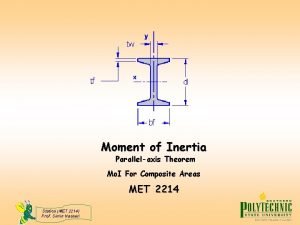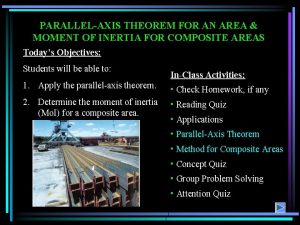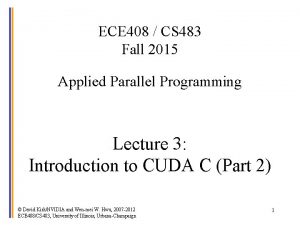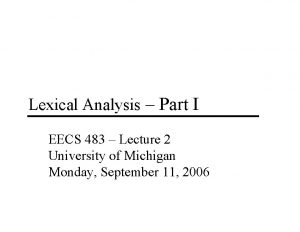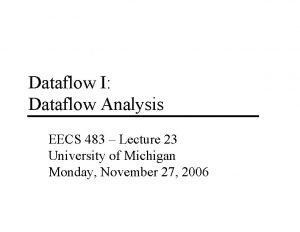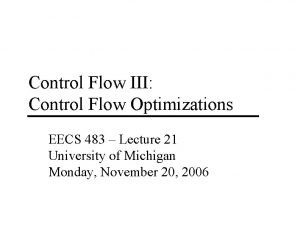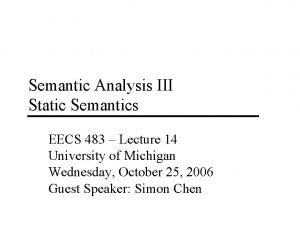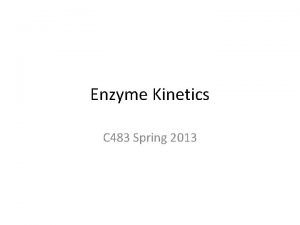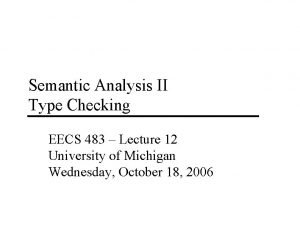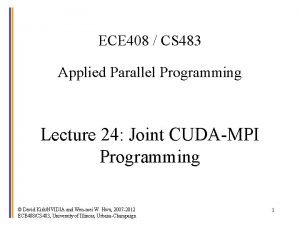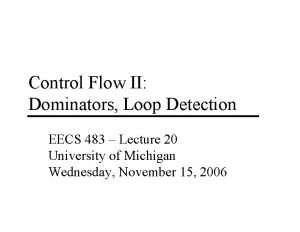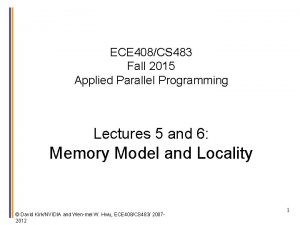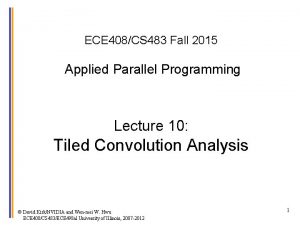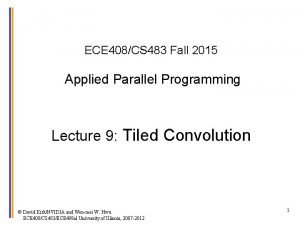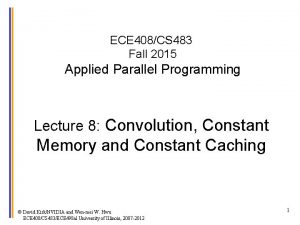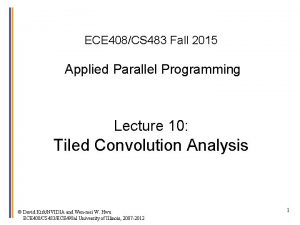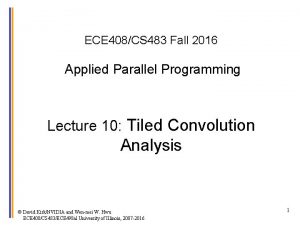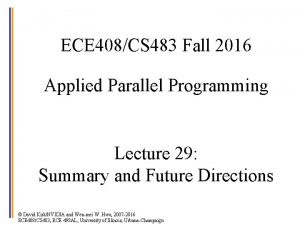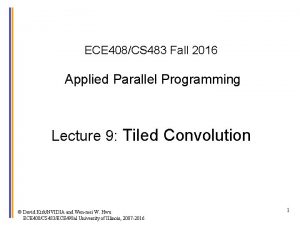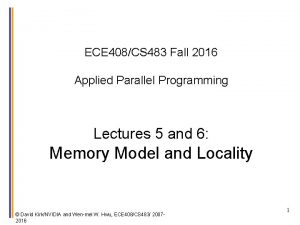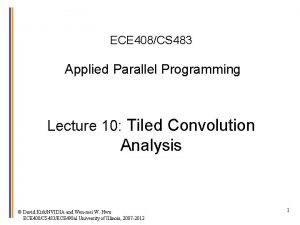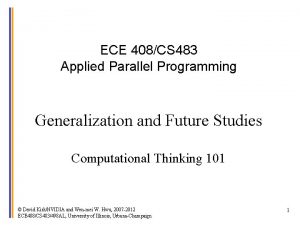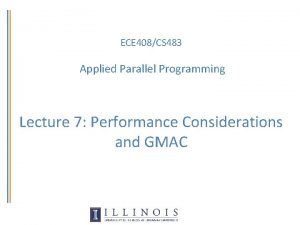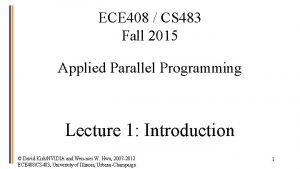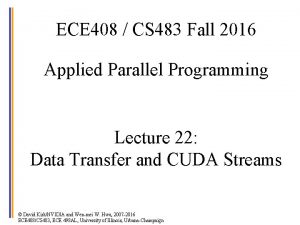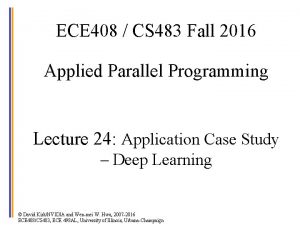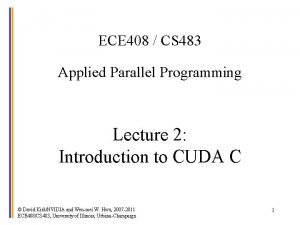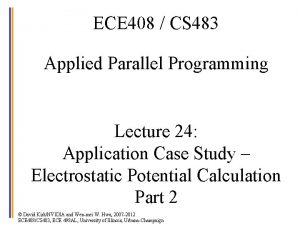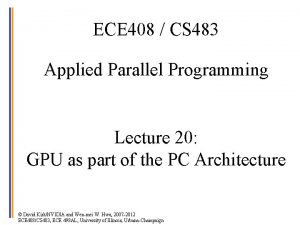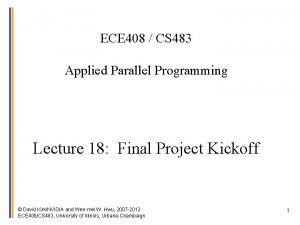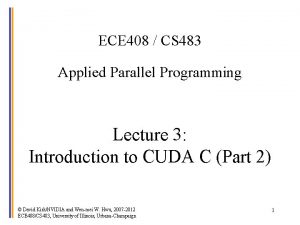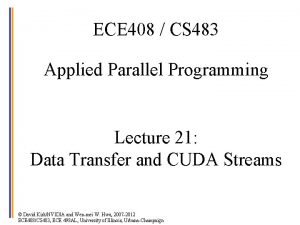ECE 408CS 483 Fall 2015 Applied Parallel Programming























![Host Code // global variable, outside any function __constant__ float Mc[KERNEL_SIZE]; … // allocate Host Code // global variable, outside any function __constant__ float Mc[KERNEL_SIZE]; … // allocate](https://slidetodoc.com/presentation_image_h/c45b6e179931ee2dfff2a0d80f8a1a4f/image-24.jpg)

- Slides: 25

ECE 408/CS 483 Fall 2015 Applied Parallel Programming Lecture 8: Convolution, Constant Memory and Constant Caching © David Kirk/NVIDIA and Wen-mei W. Hwu ECE 408/CS 483/ECE 498 al University of Illinois, 2007 -2012 1

Objective • To learn convolution, an important parallel computation pattern – Widely used in signal, image and video processing – Foundational to stencil computation used in many science and engineering • Important techniques – Taking advance of cache memories © David Kirk/NVIDIA and Wen-mei W. Hwu ECE 408/CS 483/ECE 498 al University of Illinois, 2007 -2012 2

Convolution Computation • Each output element is a weighted sum of neighboring input elements • The weights are defined as the convolution kernel – The same convolution mask is typically used for all elements of the array. © David Kirk/NVIDIA and Wen-mei W. Hwu ECE 408/CS 483/ECE 498 al University of Illinois, 2007 -2012 3

Gaussian Blur Simple Integer Gaussian Kernel © David Kirk/NVIDIA and Wen-mei W. Hwu ECE 408/CS 483/ECE 498 al University of Illinois, 2007 -2012 4

1 D Convolution Example • Commonly used for audio processing – Mask size is usually an odd number of elements for symmetry (5 in this example) • Calculation of P[2] N 1 M P N[0] N[1] N[2] N[3] N[4] N[5] N[6] 2 3 4 5 6 7 3 8 3 M[0] M[1] M[2] M[3] M[4] 3 4 5 4 3 P[0] P[1] P[2] P[3] P[4] P[5] P[6] 15 16 15 8 57 16 15 3 3

1 D Convolution Boundary Condition • Calculation of output elements near the boundaries (beginning and end) of the input array need to deal with “ghost” elements – Different policies (0, replicates of boundary values, etc. ) N P N[0] N[1] N[2] N[3] N[4] N[5] N[6] 0 1 2 3 4 5 6 7 0 4 3 Filled in M M[0] M[1] M[2] M[3] M[4] 3 4 5 4 3 P[0] P[1] P[2] P[3] P[4] P[5] P[6] 10 12 12 38 57 16 15 3 3

A 1 D Convolution Kernel with Boundary Condition Handling • All elements outside the image to set to 0 __global__ void basic_1 D_conv(float *N, float *M, float *P, int Mask_Width, int Width) { int i = block. Idx. x*block. Dim. x + thread. Idx. x; float Pvalue = 0; int N_start_point = i - (Mask_Width/2); for (int j = 0; j < Mask_Width; j++) { if (N_start_point + j >= 0 && N_start_point + j < Width) { Pvalue += N[N_start_point + j]*M[j]; } } P[i] = Pvalue; }

2 D Convolution P N 1 2 3 4 5 6 7 8 2 3 4 5 6 7 8 9 3 4 321 6 7 4 5 6 7 8 5 6 7 8 9 0 1 2 3 M 1 2 3 2 1 2 3 4 3 2 4 3 5 4 4 3 3 2 1 2 3 2 1 1 4 9 8 5 4 9 16 15 12 9 16 25 24 21 8 15 24 21 16 5 12 21 16 5

2 D Convolution Boundary Condition N P 1 2 3 4 5 6 7 8 112 3 4 5 6 7 8 9 3 4 5 6 7 8 5 6 7 8 5 6 7 8 9 0 1 2 3 M 1 2 3 2 1 2 3 4 3 2 3 4 5 4 3 2 3 4 3 2 1 2 3 2 1 0 0 0 0 4 6 6 0 0 10 12 12 0 0 12 12 10 0 0 12 10 6

2 D Convolution – Ghost Cells P N 0 0 0 3 4 5 6 0 2 3 4 5 0 3 5 6 7 0 1 1 3 1 M 1 2 3 2 1 2 3 4 3 2 179 3 4 5 4 3 2 3 4 3 2 1 2 3 2 1 0 0 0 9 16 15 12 0 8 15 16 15 0 9 20 18 14 2 3 6 1 © David Kirk/NVIDIA and Wen-mei W. Hwu ECE 408/CS 483/ECE 498 al University of Illinois, 2007 -2012 0 0 ghost cells (apron cells, halo cells) 10

Access Pattern for M • • • M is referred to as mask (a. kernel, filter, etc. ) Calculation of all output P elements need M Total of O(P*M) reads of M M is not changed during kernel Bonus - M elements are accessed in the same order when calculating all P elements • M is a good candidate for Constant Memory © David Kirk/NVIDIA and Wen-mei W. Hwu ECE 408/CS 483/ECE 498 al University of Illinois, 2007 -2012 11

Programmer View of CUDA Memories (Review) • Each thread can: – Read/write per-thread registers (~1 cycle) – Read/write per-block shared memory (~5 cycles) – Read/write per-grid global memory (~500 cycles) – Read/only per-grid constant memory (~5 cycles with caching) © David Kirk/NVIDIA and Wen-mei W. Hwu ECE 408/CS 483/ECE 498 al University of Illinois, 2007 -2012 Grid Block (0, 0) Block (1, 0) Shared Memory/L 1 cache Registers Thread (0, 0) Thread (1, 0) Host Registers Thread (0, 0) Thread (1, 0) Global Memory Constant Memory 12

Memory Hierarchies • If every time we needed a piece of data, we had to go to main memory to get it, computers would take a lot longer to do anything • On today’s processors, main memory accesses take hundreds of cycles • One solution: Caches © David Kirk/NVIDIA and Wen-mei W. Hwu ECE 408/CS 483/ECE 498 al University of Illinois, 2007 -2012 13

Cache • Cache is unit of volatile memory storage • A cache is an “array” of cache lines • Cache line can usually hold data from several consecutive memory addresses • When data is requested from memory, an entire cache line is loaded into the cache, in an attempt to reduce main memory requests © David Kirk/NVIDIA and Wen-mei W. Hwu ECE 408/CS 483/ECE 498 al University of Illinois, 2007 -2012 14

Caches - Cont’d Some definitions: – Spatial locality: is when the data elements stored in consecutive memory locations are access consecutively – Temporal locality: is when the same data element is access multiple times in short period of time • Both spatial locality and temporal locality improve the performance of caches © David Kirk/NVIDIA and Wen-mei W. Hwu ECE 408/CS 483/ECE 498 al University of Illinois, 2007 -2012 15

Scratchpad vs. Cache • Scratchpad (shared memory in CUDA) is another type of temporary storage used to relieve main memory contention. • In terms of distance from the processor, scratchpad is similar to L 1 cache. • Unlike cache, scratchpad does not necessarily hold a copy of data that is also in main memory • It requires explicit data transfer instructions, 16 whereas cache doesn’t © David Kirk/NVIDIA and Wen-mei W. Hwu ECE 408/CS 483/ECE 498 al University of Illinois, 2007 -2012

Cache Coherence Protocol • A mechanism for caches to propagate updates by their local processor to other caches (processors) The chip Processor regs L 1 Cache … Processor regs L 1 Cache Main Memory © David Kirk/NVIDIA and Wen-mei W. Hwu ECE 408/CS 483/ECE 498 al University of Illinois, 2007 -2012 17

CPU and GPU have different caching philosophy • CPU L 1 caches are usually coherent – L 1 is also replicated for each core – Even data that will be changed can be cached in L 1 – Updates to local cache copy invalidates (or less commonly updates) copies in other caches – Expensive in terms of hardware and disruption of services (cleaning bathrooms at airports. . ) • GPU L 1 caches are usually incoherent – Avoid caching data that will be modified © David Kirk/NVIDIA and Wen-mei W. Hwu ECE 408/CS 483/ECE 498 al University of Illinois, 2007 -2012 18

How to Use Constant Memory • Host code allocates, initializes variables the same way as any other variables that need o be copied to the device • Use cuda. Memcpy. To. Symbol(dest, src, size) to copy the variable into the device memory • This copy function tells the device that the variable will not be modified by the kernel and can be safely cached. © David Kirk/NVIDIA and Wen-mei W. Hwu ECE 408/CS 483/ECE 498 al University of Illinois, 2007 -2012 19

More on Constant Caching • Each SM has its own L 1 cache – Grid Low latency, high bandwidth access by all threads • However, there is no way for threads in one SM to update the L 1 cache in other SMs – No L 1 cache coherence Block (0, 0) Block (1, 0) Shared Memory/L 1 cache Registers Thread (0, 0) Thread (1, 0) Host Registers Thread (0, 0) Thread (1, 0) Global Memory Constant Memory This is not a problem if a variable is NOT modified 20 by kernel. © Davida Kirk/NVIDIA and Wen-mei W. Hwu ECE 408/CS 483/ECE 498 al University of Illinois, 2007 -2012

Some Header File Stuff for M #define KERNEL_SIZE 5 // Matrix Structure declaration typedef struct { unsigned int width; unsigned int height; float* elements; } Matrix; © David Kirk/NVIDIA and Wen-mei W. Hwu ECE 408/CS 483/ECE 498 al University of Illinois, 2007 -2012 21

Allocate. Matrix // Allocate a device matrix of dimensions height*width // If init == 0, initialize to all zeroes. // If init == 1, perform random initialization. // If init == 2, initialize matrix parameters, // but do not allocate memory Matrix Allocate. Matrix(int height, int width, int init) { Matrix M; M. width = width; M. height = height; int size = M. width * M. height; M. elements = NULL; © David Kirk/NVIDIA and Wen-mei W. Hwu ECE 408/CS 483/ECE 498 al University of Illinois, 2007 -2012 22

Allocate. Matrix() (Cont. ) // don't allocate memory on option 2 if(init == 2) return M; M. elements = (float*) malloc(size*sizeof(float)); for(unsigned int i = 0; i < M. height * M. width; i++) { M. elements[i] = (init == 0) ? (0. 0 f) : (rand() / (float)RAND_MAX); if(rand() % 2) M. elements[i] = - M. elements[i] } return M; } © David Kirk/NVIDIA and Wen-mei W. Hwu ECE 408/CS 483/ECE 498 al University of Illinois, 2007 -2012 23
![Host Code global variable outside any function constant float McKERNELSIZE allocate Host Code // global variable, outside any function __constant__ float Mc[KERNEL_SIZE]; … // allocate](https://slidetodoc.com/presentation_image_h/c45b6e179931ee2dfff2a0d80f8a1a4f/image-24.jpg)
Host Code // global variable, outside any function __constant__ float Mc[KERNEL_SIZE]; … // allocate N, P, initialize N elements, copy N to Nd Matrix M; M = Allocate. Matrix(KERNEL_SIZE, 1); // initialize M elements …. cuda. Memcpy. To. Symbol(Mc, M. elements, KERNEL_SIZE*sizeof(float)); Convolution. Kernel<<<dim. Grid, dim. Block>>>(Nd, Pd); © David Kirk/NVIDIA and Wen-mei W. Hwu ECE 408/CS 483/ECE 498 al University of Illinois, 2007 -2012 24

ANY MORE QUESTIONS? READ CHAPTER 8 © David Kirk/NVIDIA and Wen-mei W. Hwu ECE 408/CS 483/ECE 498 al University of Illinois, 2007 -2012 25
 Inertia moment
Inertia moment Inertia
Inertia Ley 483
Ley 483 Ece 408 uiuc
Ece 408 uiuc Biba n 477 ddl
Biba n 477 ddl Eecs 483 umich
Eecs 483 umich Eecs483
Eecs483 Suhu permukaan suatu benda 483 k jika tetapan wien
Suhu permukaan suatu benda 483 k jika tetapan wien Eecs 483
Eecs 483 Documentos protocolares
Documentos protocolares 483
483 Static semantic analysis
Static semantic analysis 2 147 483
2 147 483 Eecs 483
Eecs 483 Kinetics 483
Kinetics 483 Eecs 483
Eecs 483 Ley del notariado plurinacional
Ley del notariado plurinacional Ece 408
Ece 408 Dominate
Dominate Fda 483 response cover letter
Fda 483 response cover letter Perbedaan linear programming dan integer programming
Perbedaan linear programming dan integer programming Greedy algorithm vs dynamic programming
Greedy algorithm vs dynamic programming System programming vs application programming
System programming vs application programming Linear vs integer programming
Linear vs integer programming Programing adalah
Programing adalah Programming massively parallel processors
Programming massively parallel processors
